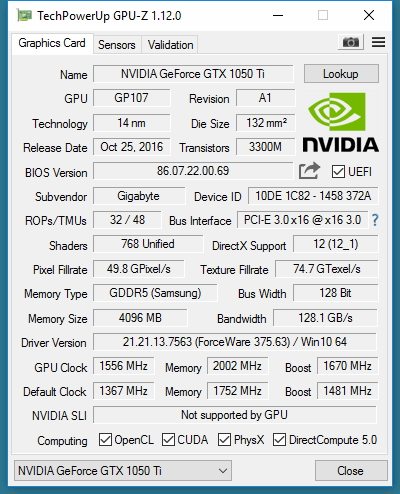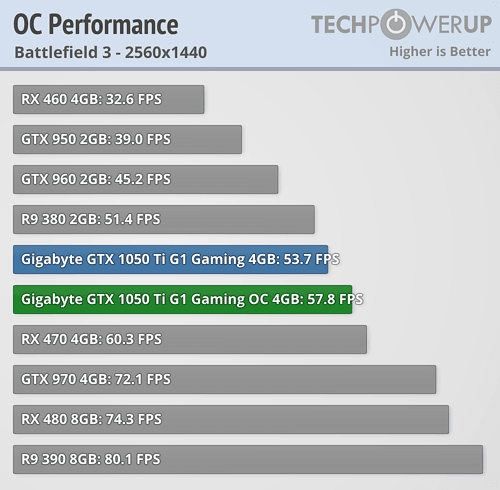 33
33
Gigabyte GTX 1050 Ti G1 Gaming 4 GB Review
Temperatures & Clock Profiles »Overclocking
Overclocking results listed in this section are achieved with the default fan and voltage settings as defined in the VGA BIOS. We choose this approach as it is the most realistic scenario for most users.Every sample overclocks differently, which is why our results here can only serve as a guideline for what you can expect from your card.
On NVIDIA cards with Boost, the values discussed are the highest observed boost clock after overclocking. The same clock increase was applied to all clock levels.

Maximum overclock of our sample is 2002 MHz on the memory (14% overclock), which is artificially limited by the NVIDIA driver. Setting any memory clock higher than 2002 MHz will only result in a memory frequency of 2002 MHz.
GPU overclocking is capped too, at 1911 MHz actual frequency after GPU Boost, but the implementation seems buggy. The actual clock can still be increased even though 1911 MHz is displayed; at beyond 1911 MHz displayed, the card will run at higher performance, and at even higher clocks, it will get increasingly unstable. Maximum overclock of our sample was +189 MHz to the GPU clock, a 14% increase.
Overclocked Performance
Using these clock frequencies, we ran a quick test of Battlefield 3 to evaluate the gains from overclocking.
Actual 3D performance gained from overclocking is 7.6%.
Apr 18th, 2024 01:40 EDT
change timezone
Latest GPU Drivers
New Forum Posts
- AMD RX 7000 series GPU Owners' Club (1064)
- Realtek Modded Audio Driver for Windows 10/11 - Only for HDAUDIO (5674)
- Will a RTX 4070 TI super bottleneck a Ryzen 9 7950X3D? (28)
- EDP other basically constantly red while playing games (1)
- Identify my GPU - RX 570 8GB (or what?) (0)
- What's your latest tech purchase? (20253)
- 4K Gamers, How much VRAM do you have? (131)
- Your PC ATM (34483)
- Free Games Thread (3765)
- DDR5 RAM Speeds and the future (24)
Popular Reviews
- Horizon Forbidden West Performance Benchmark Review - 30 GPUs Tested
- PowerColor Radeon RX 7900 GRE Hellhound Review
- ASUS GeForce RTX 4090 Matrix Platinum Review - The RTX 4090 Ti
- Fractal Design Terra Review
- Corsair 2000D Airflow Review
- Minisforum EliteMini UM780 XTX (AMD Ryzen 7 7840HS) Review
- Creative Pebble X Plus Review
- FiiO KB3 HiFi Mechanical Keyboard Review - Integrated DAC/Amp!
- ASUS GeForce RTX 4090 STRIX OC Review
- NVIDIA GeForce RTX 4090 Founders Edition Review - Impressive Performance
Controversial News Posts
- Sony PlayStation 5 Pro Specifications Confirmed, Console Arrives Before Holidays (105)
- NVIDIA Points Intel Raptor Lake CPU Users to Get Help from Intel Amid System Instability Issues (102)
- US Government Wants Nuclear Plants to Offload AI Data Center Expansion (98)
- Windows 10 Security Updates to Cost $61 After 2025, $427 by 2028 (82)
- Developers of Outpost Infinity Siege Recommend Underclocking i9-13900K and i9-14900K for Stability on Machines with RTX 4090 (82)
- TechPowerUp Hiring: Reviewers Wanted for Motherboards, Laptops, Gaming Handhelds and Prebuilt Desktops (71)
- Intel Realizes the Only Way to Save x86 is to Democratize it, Reopens x86 IP Licensing (70)
- AMD Zen 5 Execution Engine Leaked, Features True 512-bit FPU (63)